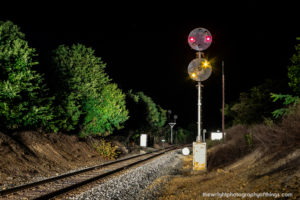Rob Paisley has a lot of model railroad circuits on his website, complete with detailed diagrams and notes for electronics beginners. For some projects, he also provides a parts list with DigiKey part numbers, and for some, he sells kits that include printed circuit boards.
I’m going to try his Infrared Proximity Detector Circuit to use with my signal system. I’ve looked at a few other block occupancy detection (BOD) methods, but the others have what I see as downfalls. With DCC, you can use a system that detects the voltage draw from the track power, which tells the system where on the line the locomotive is. The problem with this, for me, is that the rest of the train doesn’t normally draw current, and so in order to make the rest of the train trigger this type of occupancy detection, you have to install power-pickup wheels on at least some of the cars, with a resistor between the two wheels. That sounds problematic and like a lot of unnecessary hassle.
With an IR proximity detector circuit, an IR LED, hidden inside a tube below the track, in between two ties, shines invisible light straight up. An IR receiver is …

